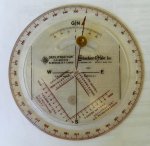dblust
FNG
In order to carry out good position plotting with map and compass, magnetic bearings taken on identifiable landmarks in the real world must be converted to grid bearings before they can be transferred to the map. This is due to magnetic declination, the difference between magnetic north and true north, or - and more importantly for the back country navigator - the difference between magnetic north and grid north.
This is readily accomplished by “doing the math.” In regions of east declination, the local declination is added to a magnetic bearing to convert it to a grid bearing, while the declination is subtracted from a grid bearing to convert it to a magnetic bearing. (The reverse is true in areas of west declination. This procedure applies to compasses that are not declination adjustable, such as the Brunton 54, Cammenga 3H/M27, and Francis Barker M73 and M88.)
In the late 1970s, Noel J. Hotchkiss invented an ingenious little gadget called a “Declitractor” that eliminated the need for map-and-compass navigators to add or subtract declination. It was available through Stocker & Yale, the New York company that then manufactured the U.S. military-issue M27 lensatic compass.
Hotchkiss’s Declitractor (sometimes called a “Whiz Wheel”) is essentially a declination-adjustable protractor, graduated in degrees.
The user sets the Declitractor for the correct grid-to-magnetic declination for the area, (set here for 10 degrees east), then uses it as a conventional protractor without doing any math - the Declitractor has already made the conversion, whether you are converting a magnetic bearing to a grid bearing, or vice versa. The key to it working properly, of course, is that it be set for the correct declination in your area.

There are two north-south grid lines on the Declitractor, which is about the size of a DVD, to align it with the map’s north-south grid lines, and corner scales for 1-25,000 and 1-50,000 scale maps. All-in-all, it’s a wonderful device for serious navigators, though finding one these days can be a little tough. (Stocker & Yale got out of the Declitractor business about the time it stopped making compasses.)
A web search showed them to be still available from a company called Military Logistics Manufacturing, but I understand that a number of people have had bad experiences with that company, so I cannot vouch for or recommend them myself. Your best bet is an occasional listing on sites like eBay.
This is readily accomplished by “doing the math.” In regions of east declination, the local declination is added to a magnetic bearing to convert it to a grid bearing, while the declination is subtracted from a grid bearing to convert it to a magnetic bearing. (The reverse is true in areas of west declination. This procedure applies to compasses that are not declination adjustable, such as the Brunton 54, Cammenga 3H/M27, and Francis Barker M73 and M88.)
In the late 1970s, Noel J. Hotchkiss invented an ingenious little gadget called a “Declitractor” that eliminated the need for map-and-compass navigators to add or subtract declination. It was available through Stocker & Yale, the New York company that then manufactured the U.S. military-issue M27 lensatic compass.
Hotchkiss’s Declitractor (sometimes called a “Whiz Wheel”) is essentially a declination-adjustable protractor, graduated in degrees.
The user sets the Declitractor for the correct grid-to-magnetic declination for the area, (set here for 10 degrees east), then uses it as a conventional protractor without doing any math - the Declitractor has already made the conversion, whether you are converting a magnetic bearing to a grid bearing, or vice versa. The key to it working properly, of course, is that it be set for the correct declination in your area.

There are two north-south grid lines on the Declitractor, which is about the size of a DVD, to align it with the map’s north-south grid lines, and corner scales for 1-25,000 and 1-50,000 scale maps. All-in-all, it’s a wonderful device for serious navigators, though finding one these days can be a little tough. (Stocker & Yale got out of the Declitractor business about the time it stopped making compasses.)
A web search showed them to be still available from a company called Military Logistics Manufacturing, but I understand that a number of people have had bad experiences with that company, so I cannot vouch for or recommend them myself. Your best bet is an occasional listing on sites like eBay.
